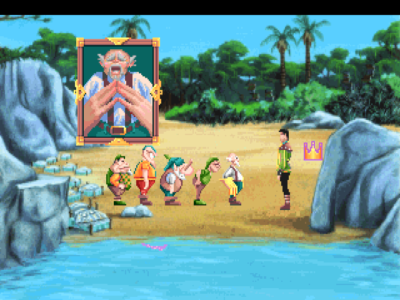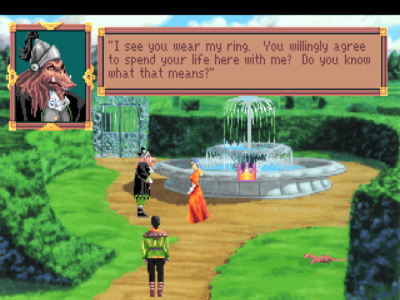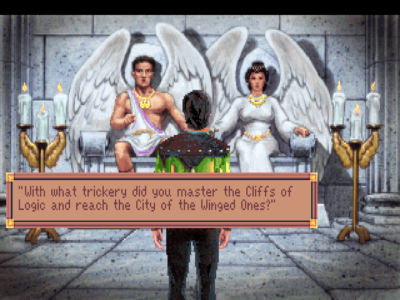
King’s Quest VI: Heir Today, Gone Tomorrow
Written by: Stoo
Date posted: April 12, 2012
- Genre: Adventure
- Developed by: Sierra
- Published by: Sierra
- Year released: 1992
- Our score: 7
King’s Quest was of course an important event in the history of gaming. Adventure games already existed, giving you a protagonist to command and a world to explore and interact with. They were based on text and, sometimes, static artwork. The important step taken by KQ designer Roberta Williams, then, was the use of animated graphics. Now you could see your hero in motion within the game’s world as you explored, solved puzzles and met characters. It’s a basic concept to us today, but I imagine it could have been rather amazing to someone playing in 1984, a new merging of visuals and interactivity.
From here, multiple sequels ensued. Sierra commissioned many other adventure series too. Yet King’s Quest remained at the core of their lineup for as long as they were in the adventuring business, until the end of the golden days of the genre in the late 90s.
Now, we’re both fans of the adventure genre, and also old-school gamers. So you’d think we’d have reviewed one of these by now. Oddly enough however, it’s never happened. We’re not actively against the series, just ambivalent, with a history of acknowledging that we really should try sometime, then shuffling off and finding something else to do. I think it comes down to perceiving the games as somewhat bland, a collection of very generic fairytale tropes.
On top of that, for all its significance I’m never going to get around to playing and writing about the original. Not even the 1990 remake. I tried briefly and found it had no real story, just an item hunt populated by wolves and fairies and lots moments of sudden death. In fact I think I fell in a moat or something stupid.
I’m not really saying this to be critical – back then the Williams’ were still working out what a graphical adventure was meant to be. Still I don’t think it would be a good use of my time, or material for an interesting 1500 word piece, to slog through something I don’t enjoy then write “too dated to be much fun”. We only tend to write negative writeups of oldies that we feel sucked according to the standards of the year they were released (Hi Megarace!). I skipped the clunky first entry in the Warcraft series for similar reasons.

Look at the funny silly gnomes with their big hand and ears! If you make just one mistake, they will kill you!
That said, I do think we all have our own personal level of what retro gaming is still enjoyable and what’s finally gone off the cliff edge of age. It’s all a bit subjective. For a great writeup from someone more dedicated to the really early adventures, go have a read at Just Games Retro.
So then, what about one the many sequels? Yep we’re skipping right to number six. There is a good reason for this, in that KQ6 and I have unfinished business. You see I first got this game with my first CD-rom drive. My 14-year old self was greatly excited at the prospect of playing a CD-enhanced adventure. Digitised speech! CG intro! Then it went and crashed on the first screen. Every time. Not a great introduction to CD-gaming, especially as the other game I got with that drive was Megarace.
I’ve had a few more attempts over more recent years with a view to writing here. Some were stifled by lack of a manual and the copy-protection info within. Later tries ended with game crashing at certain points with complaints about stack overflow. Stack of… memory I guess? Or pancakes? I’m not a programmer. In any case I hadn’t kept an earlier savegame and due to aforementioned ambivalence wasn’t motivated enough to restart.
Fortunately I was inspired to have another go when I saw the KQ 4-6 bundle on Gog.com’s Christmas sale. So, KQ6 was granted some of my precious Christmas gaming time. That’s dedication for you.
So then KQ6 casts you as prince Alexander of Daventry, and son of the feathered-cap wearing hero of earlier titles. In the previous game he met the lovely princess Cassima of the mysterious Green Isles. Following a vision in a magic mirror where she calls out for his help, Alexander decides he must pay her a visit and sets out by boat. This by the way is all told in that CG cinematic that looked astounding to my young self in the mid 90s, but really hasn’t aged well.
Anyway tho, the mission gets off to a bad start, with his boat being wrecked as he reaches the isles, leaving him alone and without resources in a strange land. Furthermore, all is not well in the Green Isles. The princess is apparently not taking visitors, as she’s mourning the sudden death of her parents, according to the deeply dodgy grand Vizier. Oh and she’s due to marry him, fancy that. Meanwhile the once harmonious isles have fallen into some kind of sullen feud and broken off communications. What a mess, clearly requiring a princely hero to clear it all up.
So then the game takes place over five or so islands, which you can travel between fairly freely. Each has a distinctive style. So the main island is all a bit Arabian nights, but another is based on Beauty and the Beast. Another is just surreal, kind of a children’s book gone mad, populated by animated chess pieces, and an educated giant bookworm. A final one has a bit of ancient greece going on.
I mentioned thinking of this series as fairly bland and generic, a lot of medieval-based “wizard in a tower in the forest” type fantasy or fairytales. In fact as you can see it’s more like a collection of all different fantasy tropes. There’s still not a lot of originality at work – you might wish for something a bit more inspired, for a writer to try and create a fantasy world more of their own. Still, I found its style quite engaging. The green Isles are a presented as a vibrant and colourful place, and spending a while poking around, I was keen to uncover more of the mysteries. I took the game as a tribute to assorted bits of well known story and mythology, and enjoyed it on those terms.
The patchwork approach also means for a lot of variety in environment. One minute marble palaces, the next something out of a Lewis Caroll story. I guess you could argue that means a lack of coherence. But I think the overall feel of the story holds it together, a whimsical look at a strange, tucked away land where magic infuses reality to such an extent it gets a little weird around the edges.

Tale as old as tiiiiime… wait, sorry, no singing teapots here.
There’s another subtle factor that I’d forgotten about until doing my in-depth research, by which I mean reading mobygames reviews. The game employs a lot of textual descriptions as to what happens – “alexander tentatively offers the mint to the gnome with the enormous tongue”. You might ask why that’s necessary, why not just show us? But by having a narrator, it engages the player by overlapping into the feel of a storybook. Which suits the material here, I think.
As for our hero himself, a well-meaning and earnest stranger to these lands, I was rooting for him before too long. What’s important, as much so as the kooky fantasy, is that the narrative here is a love story. It’s not one with enormous amounts of depth. However it does have heartwarming sincerity, and I felt the genuine desire to help these young lovers out. Am I getting sappy in my old age? Eh, I’m happy to ditch my 20something aloof cycnism.
Now I realise I might be painting this to a newcomer as something totally whimisical or sappy. It is definitely what I’d call family friendly, but it’s not totally sanitised in tone. The one place where really I felt it was a little too silly was regarding the main villain and his backup, who verge on pantomime at times. There are plenty of darker themes in other palces.
So you soon find out those dumpy gnomes on the isle of wonder have orders to eject you with lethal force. Or how about a session locked in a labyrinth with a minotaur? He’s not exactly looking for hugs. There’s also a trip to the underworld which I thought was genuinely creepy, and the lord of that realm is a rather tragic character.
This brings me to the concept of dying in an adventure game. Of course this can be annoying in its own manner, to those of us who preferred Lucasarts’ more laid-back approach. Still sources of danger aren’t too arbitrary here. Maybe Sierra mellowed a bit over the 90s. If something can potentially kill you, it’s normally pretty obvious. (“Hello stranger, come over here! Don’t mind that statue tracking you with a drawn longbow!”). Oh and don’t go for a swim. You were warned in the intro.
Moving on, what’s also noteworthy about KQ6 is how it splits into two paths towards the end. One is shorter and easier. The other takes longer, but allows you to meet some other objectives along the way. So whatever happens, Alex does get the girl. However if you’ve been more thorough, he might also learn what happened to the former king and queen, and bring harmony back to the lands. It’s a more comprehensive wrapping up of the situation and of Alex and Cassima’s story, and therefore more rewarding.
Generally whichever way you go it’s not too mentally stressful. I tend to count these things in terms of how often I run scurrying to gamefaqs, and it was probably a couple of times for this one. And I’m impatient. There is a danger of getting stuck in an unwinnable situation at one point, which I often get paranoid about in old sierra games. You are warned once not to continue until you have the items you needm and are given one chance to leave that place and look for them. But it’s not spelled out what they are, and when you go back you’re stuck. It’s an annoyance but mostly you just need to be sensible and keep a few savegames preserved at key points in the story.
Oh and some puzzles are just thinly thinly veiled copy-protection, requiring you to sift information from the manual. Still the material is written into extra back-story on the Green Isles, so not totally tedious.
So then what else to say. Plastic intro aside, the VGA artwork is of the usual warm and engaging Sierra standard. Characters get “talking head” type portraits which helps greatly in making them come to life. It makes up for main character sprites not having sufficient resolution to properly show features. The interface as usual for SCI games is nicely unobtrusive, disappearing when you’re not selecting an interaction option.

The king of these angelic people is actually kind of a douche.
Music is jangly midi, which might sound pretty feeble to modern gamers but I always have a fondness for it. The tone is set as required anyway –relaxing, regal, whimsical. While rounding up audio-visual though, I’ll make one grumble. The voice acting is I think a mixed bag – some efforts fall into the aforementioned unwelcome comedy. Also though, I wish it would let you have text and speech at the same time, so you could move quickly through less interesting conversations whilst still getting the information.
So then, we finally acknowledge a King’s Quest. I’ve realised this article has ended up full of statements of the form “here’s a criticism, but”. Partially that’s because criticisms are easier to construct in detail than praise. Ultimately this is not a game that gets by on the strength of inspired originality. Also it is, on some level, whimsical and lightweight fluff.
However, I am glad I made the effort. The varied collection of fairytale themes and the straightforward and charming story make for some decently-crafted escapism. It worked for me as feelgood fare, a change of pace in between grimdark war games or grinding through dungeons endlessly slaughtering demons. For a way of spending Christmas gaming time, in between large dinners and watching movies, it was really quite suitable.


 Posts
Posts